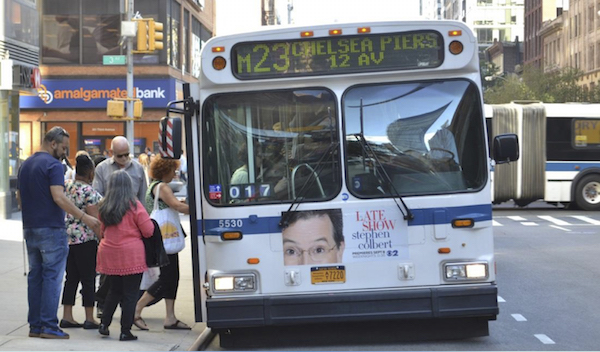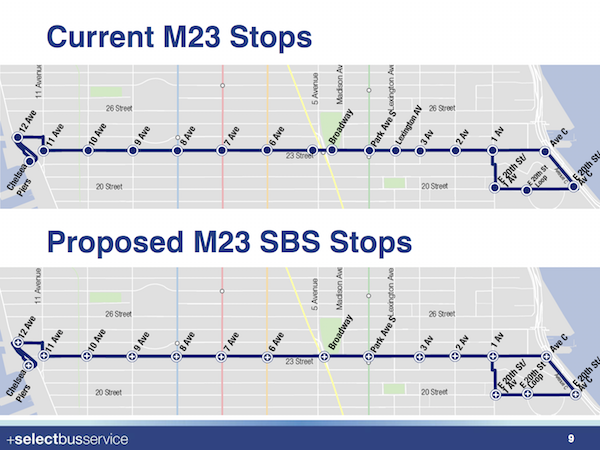
BY SEAN EGAN | A new M23 Select Bus Service (SBS) line is forthcoming — an effort to help increase the efficiency of the consistently sluggish M23 line along W. 23rd St. — and news of the upgrade has the Chelsea community eagerly anticipating improvements, while voicing concerns about issues that may arise because of the line’s launch.
A notoriously slow route, the M23 runs from Chelsea Piers to E. 20th St./Ave. C — mostly along W. 23rd St. — and currently serves 15,000 passengers daily. An October 2015 presentation by the Department of Transportation (DOT) and the Metropolitan Transit Authority (MTA) reports that 51% of the time, the M23 is either stopped in traffic or at a bus stop. Of the time moving on the road, 9% is spent below 2.5mph, and the vast majority of the rest of the time is spent under 8mph.
SBS bus lines feature devoted bus-only lanes (marked with distinctive red paint) to speed along routes, and also employs off-board fare collection kiosks at bus stops (which dispense tickets to customers) to reduce time-consuming on-board MetroCard swipes.
In addition, SBS bus lines seek to eliminate stops that are redundant or underused, in order to speed along the route. Stops that would be dropped from the M23 would be its Lexington Ave. and Fifth Ave. stops (with the Broadway stop shifting slightly closer to the current Fifth Ave. stop site).
The project, as handled by the DOT and the MTA, is currently in its implementation phase — which includes installing infrastructure for the line.
Community Board 4 (CB4), whose area of coverage includes a large portion of the M23’s route, appears relatively positive about the prospects for the new line. After a presentation was delivered to its Transportation Committee in June, a letter was drafted expressing general approval, and outlining suggestions. It was approved to be sent to the DOT’s Manhattan borough commissioner and the MTA president at CB4’s July 27 full board meeting.
While it did state, “CB4 supports the overall plan,” and praised the possibility of a new bench at Seventh Ave. and the installation of bus clocks at certain stops, they did voice some concerns.
“We strongly object to the placement of the fare payment machines in their current configuration and request that it be changed,” reads a portion of the letter. “We continue to hear negative comments on the fare collection system from all users in our district, and particularly from users of scooters and wheelchairs: The location of the fare payment machines makes it extremely difficult if not dangerous for these users to maneuver their scooter on the very narrow gangway adjacent to the moving traffic.”
They called for augmentation at the 10th Ave. intersection, to avoid traffic issues at this busy site, recommending a turn bay and split-phase signal be installed at the location. “At a minimum,” the letter reads, “a trailing green arrow signal should be installed.”

Concern over this particular area was echoed and amplified by one community resident, Susan Numeroff, who was present at the full board meeting, and spoke out against the MTA and the DOT during the public comments section — claiming that the agencies moved ahead with their plans too hastily, and without studying the area enough.
Speaking with Chelsea Now by phone after the CB4 meeting, Numeroff said the area of W. 23rd St. between Ninth and 10th Aves. “is very heavily residential, and the traffic that is accumulated on the north side of the street in the evenings — in particular to the Lincoln Tunnel — is tremendous,” adding that traffic sometimes stretches all the way back to Eighth Ave. The SBS, as currently planned, would further exacerbate problems with traffic congestion on the block, and make life more dangerous for pedestrians — desperately requiring some new systems to be put in place for motorists trying to turn on the block.
“Already we have an accumulation of traffic now daily, for the past week,” she noted, as the SBS bus lane has already been painted on her block. “I don’t think they’ve really done their homework well, and I guess they bulldozed, and are doing what they’re doing.”
When reached for comment about the concern surrounding the issue, a DOT spokesperson told this paper, on background, that the agency is aware of the concern and is examining if improvements to the area — including split-phase signals and left turn bays — would be possible to implement.
They went on to maintain, however, that after their studies, the SBS would be able to improve customers’ commuting experience and further Mayor de Blasio’s Vision Zero initiative.
The MTA could not confirm a specific launch date for the M23 SBS, but it is expected to be fully functional sometime between now and September.

















